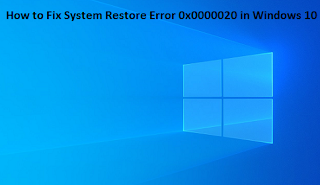How to Fix System Restore Error 0x0000020 in Windows 10
System Restore is one of the useful utility programs used to restore system files for the program execution process. This feature is used to revert the system’s state to the point where the computer was performing smoothly. It’s the feature that used to revert the system data to the previous date and time. In some cases, while trying to access the “System Restore” feature, the screen shows an error message regarding the failure of this particular function. It comes with an error code 0x0000020 on the system’s Windows 10.
Source: How to Fix System Restore Error 0x0000020 in Windows 10
There are multiple reasons for arising this error message, such as corrupted system files, Outdated Windows edition, or malfunctioning of various components of the Operating System. The other possible issue for this error is the disconnection of the router etc.
For troubleshooting the error code 0x0000020, pursue these guidelines:
Error Code 0x0000020 and Its Possible Reasons
We are providing you various reasons why this error issue occurs on Windows 10. Various strategies are applied by numerous users and reported that they had fixed the issue successfully. Below are the possible causes and reasons for the System Restore function error issue:
Older or Outdated Version: Sometimes, users forget to download the recent update of the available Windows resulting in the crash or failure of System data, and this is one of the prominent reasons behind this error issue.
System Data Corruption: While working on Windows 10, various malware and viruses attack online and offline mode to our data, and thus they get infected or damaged. Corrupted System File invites a number of problems to our devices. It is recommended to keep the windows OS up to date and use a reliable antivirus program to troubleshoot the issue. One can also use DISM or SFC tools for detecting and removing various malware, spyware, and other unnecessary harmful elements.
Damaged OS Equipment: In case the Operating Systems get corrupted and affecting your device, then it’s recommended to refresh all the components attached to your OS functionalities. Corrupted or damaged components might harm your device or wipes your data entirely. You can install repair tools or perform the clean installation for downloading various applications.
Pursue these mentioned instructions to repair this issue through this renowned potential and reliable fixes. These will help you lot in troubleshooting these instructions:
Installing Pending Updates
Microsoft automatically releases and fixes various issues related to Windows update. If your device has any pending updates, then install it instantly. Forgetting to update the Windows 10 OS is might be the prominent reason behind this error issue. Various users managed to troubleshoot the error issue 0x000020 on their Windows 10 by updating the OS to the latest edition.
- First and foremost, tap Window logo and R keys simultaneously to launch the Run Dialog box.
- After that, you have to enter these keywords “ms_settings_windows_update,” followed by the Enter key. This action will expand the page of the Windows update. It will also be available inside the Settings application.
- When you have successfully entered the screen of Windows update, then navigate towards the right side section and hit the Check for updates option there.
- After that, pursue all the onscreen instructions to download the pending update related to your Windows 10. It will provide access to all the latest features related to your device and OS.
Note: In case you are asked to restart the device just prior to each update section, you should do the same and ensure that you have to perform the entire necessary task for recent updates.
- Once you have performed all the steps mentioned above successfully, and then reboot the device to ensure that the system has accepted all the modifications that you have made.
- In case you are still facing the error code 0x00000020, then move to the next procedure to fix the issue.
Performing SFC and DISM Scanning Tool
- In the beginning, launch Run Prompt box and insert “cmd” into the search section.
- Then, hit the Enter key to proceed.
- After that, apply the right mouse click on the top resulting option “Command Prompt.”
Note: Make sure to provide the system to fetch all the admin rights. To do so, hit the Yes tab for providing admin privileges.
Initiating DISM Scanning Procedure
- Enter these keywords into the command window:
“Dism|_exe //online /_cleanup-image /_scan_health”
“Dism|_exe //online _cleanup_image /_restore_health.”
- After that, hit the Enter key to proceed.
Note: It is advised not to shut the window of Command Prompt until you view the prompt message regarding the successful completion of the process.
- Once the procedure completes, then reboot the PC for the internal process to capture the modifications.
Running SFC Scanning
- Now, relaunch the Command Line Page with administrative rights and enter “sfc/_scannow,” followed by tapping the Enter key.
- Reboot the device to overcome this error issue.
Running Windows Update Troubleshooter Tool
- At the start, tap Window logo and S tab simultaneously.
- Then, enter the keyword: “troubleshooting” into the provided space.
- Now go to the Security and System, and the hit the Fix problem-related option. This will be available inside the section of the Control Panel.
- Go to the lowermost section of the page and then hit the option “Advanced Link.”
- Then, hit the Next tab and tap on the Admin related link.
- Press the Next button there. Then the tool will initiate the troubleshooting process.
- When any of the problems are scanned and found, then hit the Apply this Fix tab there.
Becky Losby is a self-professed security expert; he has been making the people aware of the security threats. His passion is to write about Cyber security, cryptography, malware, social engineering, internet and new media. He writes for Norton security products at norton.com/setup.
